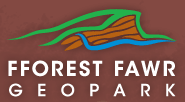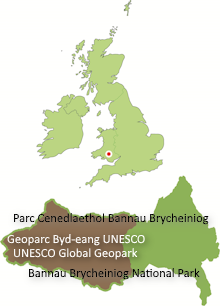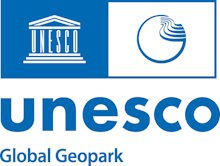Glossary of geological terms
ABCDEFGHI J KL
MN OP QRSTU VW X Y Z
U
Unconformity / Anghydffurfedd
An interval of time during which no sediments are laid down or else existing rocks or sediments are eroded away. Eventually more sediments are laid down on the eroded surface but there remains a ‘gap’ in the rock record.
A good example is the sequence of Devonian age ‘Old Red Sandstone’ rocks in Fforest Fawr Geopark where the rocks of the ‘Brownstones Formation’ were laid down during early Devonian times and those of the overlying ‘Plateau Beds Formation’ laid down during late Devonian times.
There are no middle Devonian rocks between them – any rocks of that age were either a) deposited then eroded away before the Plateau Beds were deposited, or b) never deposited at all
Upper Coal Measures / Cystradau Glo Uchaf
Traditional subdivision of the Carboniferous Period. See Carboniferous timechart.
Upper Devonian / Defonaidd Uchaf
See Devonian timechart.
Upper Limestone Shale(s) / Sial(au) Calchfaen Uchaf
Succession of rocks lying at the top of the main Carboniferous Limestone. Now known as the Oystermouth Formation.
Usk Glacier / Rhewlif Wysg
A glacier or river of ice which flowed down the valley of the present-day River Usk during one or more of the ice ages. The furthest point downstream which it ever reached was the town of Usk in Gwent.
V
Variscan Mountains / Mynyddoedd Farisgaidd
Former mountain range raised up to the south of Britain during the Variscan Orogeny. Pebbles, sand and mud eroded from them helped to form the Pennant Sandstone of South Wales.
Variscan Orogeny / Orogeni Farisgaidd
Mountain-building episode which took place during the Devonian and Carboniferous periods resulting from the collision of the former continents of Laurasia and Gondwana to form Pangaea. Fforest Fawr was affected only by the ‘outer ripples’ of this event. Its legacies include the South Wales Coalfield Syncline and elements of the Neath Disturbance – though this originated in the earlier Caledonian Orogeny.
Variscides / Gwregys Orogenig Farisgaidd
The rocks and geological structures associated with the Variscan Orogeny. They lie for the most part to the south of the so-called Variscan Front – a line running ESE-WNW through the Vale of Glamorgan, Gower and southern Pembrokeshire.
Vaughan’s biozones / Bio-parthau Vaughan
In 1905 geologist, Arthur Vaughan divided the Carboniferous Limestone into zones based on the presence of certain ‘index fossils’ associated with particular beds of limestone. The C1, C2, D1, D2, K, S1, S2 and Z ‘biozones’ are characterised by the fossil corals Caninia (C), Dibunophyllum (D), Cleistopora (K) and Zaphrentis (Z) respectively together with a fossil brachiopod Seminula (S). These zones equated to variously aged parts of the limestone succession – a mention in older publications of the ‘S2 limestone’ would refer to (for example) the Dowlais Limestone.



